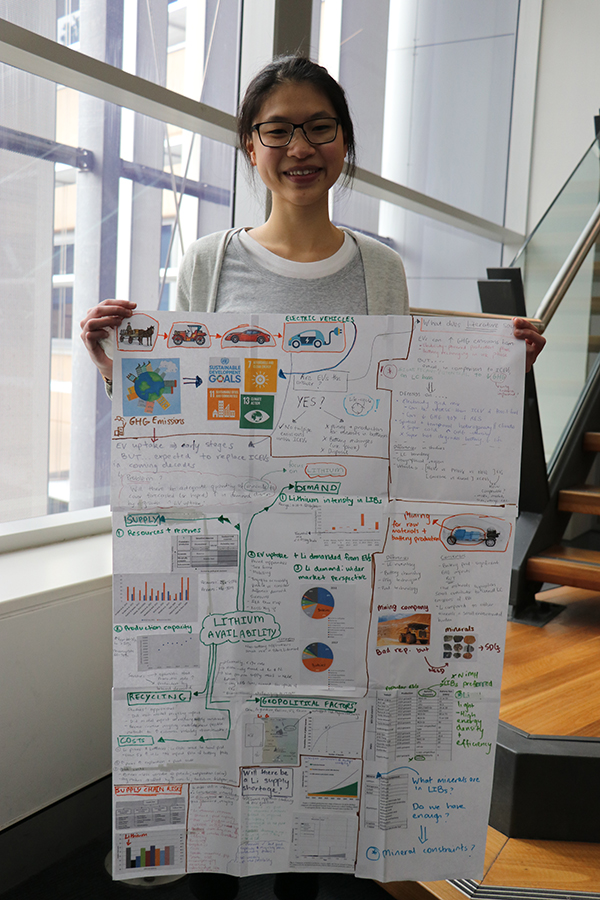It’s a routine weekday morning. You’ve gotten ready for the day. You’ve walked outside and unlocked your car. You’ve put your keys in the ignition, but there's one massive problem.
From the moment you start your car engine to when you arrive at your destination, a substantial amount of greenhouse gases will have entered the Earth’s atmosphere. Multiply that by how many cars are on the road, and it's easy to see how the transport sector is one of the largest contributors of greenhouse gases.
I would say fairly confidently that most of us recognise climate change and its implications and are wanting to play our part. However, there is also the other part that vehemently protests: “But I need my car! I can’t just stop driving my car around!”
And so I ask “Are electric vehicles the answer to our problem?”
This was the question I found myself researching during my internship at The University of Queensland’s Sustainable Minerals Institute (SMI).
If you’re anything like “pre-Jane” – me before my time at the SMI, you’re probably thinking: “Of course electric cars are better for the environment. I don’t know that much about them, but they don’t emit tailpipe emissions unlike the vehicles most of us drive.” However, what “pre-Jane” failed to consider was that electric vehicles are powered by batteries which require certain minerals, and the mining and production of these minerals have implications for carbon emissions. What’s more, recharging the batteries requires electricity, which also has implications for carbon emissions. Hence, emissions are just one bit of the story.
To evaluate the greenhouse gas impacts of electric vehicles, one needs to adopt a broader life-cycle perspective.
 With a little research you’ll find that the life-cycle comparison between conventional and electric vehicles is far from black and white. It depends on many factors and assumptions, including how you define your life-cycle boundaries, which geographical region and climate you focus on, and the vehicles used in your analysis. But a common thing that all studies point out is that electric vehicles are not as environmentally harmless as they may first appear. When considering their ability to reduce greenhouse gas emissions, remember electric vehicles can contribute significant emissions from their electricity-powered production phase and battery recharging during their use phase. In fact, some studies found that if your electricity grid mix is largely dominated by fossil fuel, electric vehicles can be guilty of emitting higher greenhouse gases than conventional vehicles on a life-cycle basis! Conversely (and much less surprising), electric vehicles can offer as much as 90% reductions in greenhouse gases if they are run on renewable fuels.
With a little research you’ll find that the life-cycle comparison between conventional and electric vehicles is far from black and white. It depends on many factors and assumptions, including how you define your life-cycle boundaries, which geographical region and climate you focus on, and the vehicles used in your analysis. But a common thing that all studies point out is that electric vehicles are not as environmentally harmless as they may first appear. When considering their ability to reduce greenhouse gas emissions, remember electric vehicles can contribute significant emissions from their electricity-powered production phase and battery recharging during their use phase. In fact, some studies found that if your electricity grid mix is largely dominated by fossil fuel, electric vehicles can be guilty of emitting higher greenhouse gases than conventional vehicles on a life-cycle basis! Conversely (and much less surprising), electric vehicles can offer as much as 90% reductions in greenhouse gases if they are run on renewable fuels.
Overall, the studies I read suggested that electric vehicles are still a highly promising answer to our need to significantly reduce transport greenhouse gas emissions. In the face of increasing environmental pressures and implications surrounding fossil fuel depletion and global warming, this is good news, right? And here I feel obliged to admit that “pre-Jane” would have said “Yes, it is! However, what “pre-Jane” failed to stop and consider is this: do we actually have a sufficient supply of raw materials to support a mass switch from conventional to electric vehicles? In particular, will we have lithium supply constraints which will hinder mass electric vehicle production?
For those of you who aren’t aware, lithium-ion batteries are what you find in most electric vehicles today. It’s predicted that it will stay this way for the foreseeable future. This is due to lithium’s many favourable properties, including its light weight and high energy and density. Lithium-ion batteries are also superior to other batteries in terms of relative cost, safety and cycle life.
To answer the question about future lithium availability, I considered lithium supply in terms of resources and reserves, and mining production capacity. Next, I considered demand, namely, lithium intensity in batteries, future electric vehicle uptake scenarios and lithium demanded from electric vehicles and other market end-uses. I also examined the potential impacts of recycling, costs and geopolitical factors. And… Will there be a sufficient supply of lithium to support high demand driven by widespread adoption of electric vehicles? The answer to that question is unclear!
There are just so many variables. I’ll also emphasise that the studies I looked at defined the question around lithium supply shortages differently. Moreover, it depends on whether you are considering demand and supply at one point in time or cumulatively. What I’m trying to get at is that the lithium supply and demand relationship is dynamic, and conclusions provided in literature are tentative.
So, if you’ve reached this stage of the blog you’ll realise that “post-Jane” now knows that from a life-cycle perspective, electric vehicles aren’t innocent when it comes to greenhouse gas emissions. “Post-Jane” is also aware– that while it’s all good to hope that in the future everyone will be driving electric vehicles, this may be hindered by material constraints. And “post-Jane” will also be slower to immediately equate mining with only “bad things” for the environment. Electric vehicles – which require minerals like lithium, is one example of how mining in fact, has an important role in our transition into cleaner energy technologies.

